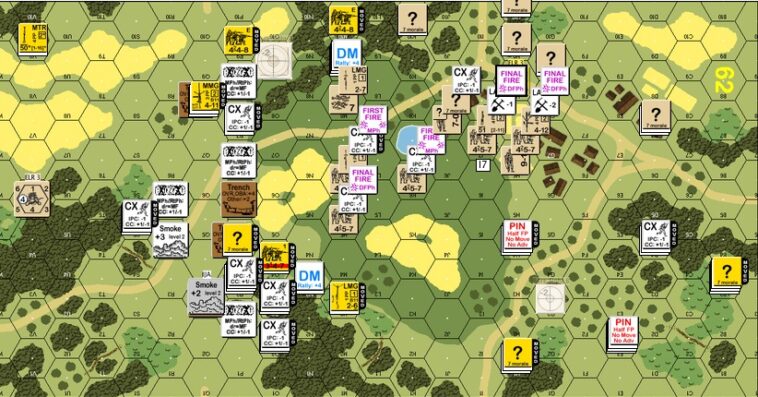In the realm of board gaming, enthusiasts seeking an intellectual challenge and strategic depth often find solace in the most difficult board games. These intricate masterpieces not only test players’ cognitive abilities but also demand strategic thinking, planning, and a dash of luck to emerge victorious. In this comprehensive guide, we delve into the world of brain-teasing complexity, exploring the most difficult board games that push players to their mental limits. From intense strategy sessions to intricate rule sets, these challenging games promise an unparalleled gaming experience for those who crave the thrill of outsmarting their opponents.
The Most Difficult Board Games
- Advanced Squad Leader
- Star Wars: Rebellion
- Magic Realm
- Dead of Winter
- Arkham Horror
- Eldritch Horror
- War of the Ring: Second Edition
- Scythe
- Twilight Imperium
- Gloomhaven
- Gaia Project
Advanced Squad Leader
Advanced Squad Leader (ASL) earns its reputation as one of the most difficult board games through its intricate ruleset, strategic depth, and attention to historical detail. ASL stands out as the pinnacle of tactical wargaming, simulating infantry combat scenarios during World War II. The rulebook for ASL is notoriously dense, comprising an extensive series of manuals that cover a myriad of scenarios, units, and terrain types. Players must navigate a labyrinth of rules governing line of sight, unit capabilities, and combat resolution, making every decision a meticulous calculation.
The game’s modular design allows for countless combinations of scenarios, ensuring a virtually infinite replayability factor. ASL’s complexity lies not just in its rule complexity but also in the tactical challenges it presents, demanding strategic thinking, precise planning, and an in-depth understanding of military tactics.
Star Wars: Rebellion
Star Wars: Rebellion stands out as one of the most complex board games, immersing players into the epic galactic conflict between the Rebel Alliance and the Galactic Empire. Designed by Corey Konieczka and published by Fantasy Flight Games, Rebellion captures the essence of the Star Wars universe with an intricate web of strategic decisions, asymmetric gameplay, and expansive mechanics. The game’s complexity is evident in its numerous components, including over 150 miniatures, a detailed game board representing the galaxy, and a plethora of cards and tokens.
Players must manage not only military forces but also engage in diplomacy, conduct covert missions, and master the art of resource management. The asymmetric nature of the game, with the Rebels focusing on guerilla warfare and the Empire on domination, adds another layer of complexity. The interplay of various systems, combined with the thematic depth and attention to detail, makes Star Wars: Rebellion a challenging and engaging experience that truly captures the grand scale of the Star Wars saga.
Also Read: The Best Space Games for PC
Magic Realm
Magic Realm stands as a hallmark of complexity in the world of board games, offering players a sprawling and intricate fantasy realm to explore. Designed by Richard Hamblen and published by Avalon Hill, this epic game boasts an expansive game board, an array of detailed components, and a rulebook that rivals the sheer size of the mythical world it represents. What sets Magic Realm apart is the staggering depth of its ruleset, encompassing various characters, creatures, spells, and scenarios, each contributing to the game’s strategic richness.
With over 16 characters to choose from, a plethora of magical items, and diverse scenarios, players must navigate a dynamic and ever-changing landscape. The game’s emphasis on storytelling, exploration, and strategic decision-making adds layers of complexity, making each playthrough a unique and challenging experience. Magic Realm’s reputation for complexity is not merely due to its rulebook’s thickness but the intricate interplay of its components, offering a deep and immersive journey into a fantasy world where every choice resonates across the unfolding narrative.
Dead of Winter
Dead of Winter earns its reputation as one of the most complex board games by seamlessly blending thematic depth, strategic intricacies, and a unique traitor mechanic. Designed by Isaac Vega and Jonathan Gilmour, published by Plaid Hat Games, this survival horror game immerses players in a post-apocalyptic world overrun by zombies. What sets Dead of Winter apart is its emphasis on narrative storytelling and the Crossroads card system, which introduces unpredictable events based on player decisions.
The game’s complexity is further heightened by the inclusion of multiple objectives, character-specific goals, and the constant looming threat of betrayal. The Crossroads system injects narrative twists, and the game’s survival mechanics, ranging from managing resources to dealing with the potential betrayal of fellow players, make every decision crucial. With its intricate balance of thematic immersion and strategic depth, Dead of Winter offers a complex and gripping board gaming experience, keeping players on the edge of their seats as they navigate the challenges of a world plunged into darkness.
Also Read: The Best Free Horror Games on Steam
Arkham Horror
Arkham Horror plunges players into the eldritch horrors of H.P. Lovecraft’s Cthulhu Mythos. Published by Fantasy Flight Games, designed by Richard Launius and Kevin Wilson, this cooperative game takes complexity to a new level with its dense rulebook, intricate mechanics, and atmospheric storytelling. Set in the fictional town of Arkham, players assume the roles of investigators striving to prevent the awakening of ancient, malevolent entities. The game’s complexity is evident in its numerous components, including a vast array of cards, tokens, and an expansive board that evolves with each playthrough.
The constantly escalating terror level, the need for strategic cooperation, and the inclusion of otherworldly events contribute to the game’s depth. With multiple expansions expanding the game universe, Arkham Horror immerses players in a narrative-rich and deeply complex experience, where every decision matters in the cosmic battle against unspeakable horrors.
Eldritch Horror
Eldritch Horror stands as a pinnacle of complexity in the realm of board games, seamlessly weaving together intricate storytelling, strategic depth, and a relentless sense of impending doom. Published by Fantasy Flight Games and designed by Corey Konieczka and Nikki Valens, this cooperative adventure takes players on a global quest to confront ancient, cosmic horrors threatening to plunge the world into chaos. The game’s complexity emerges from its multitude of interlocking systems, encompassing unique investigator abilities, vast mythos decks, and dynamic encounter phases.
The globe-trotting nature of Eldritch Horror introduces a strategic layer, as players must manage resources, solve mysteries, and navigate through a web of otherworldly challenges. The introduction of expansion packs further deepens the complexity, offering new investigators, Ancient Ones, and additional narrative threads. Eldritch Horror’s blend of thematic immersion, strategic decision-making, and a sprawling array of components solidifies its status as one of the most complex and engrossing board games, where each playthrough becomes an epic struggle against cosmic forces beyond human comprehension.
Also Read: The Best Multiplayer Horror Games to Play with Friends
War of the Ring: Second Edition
War of the Ring: Second Edition earns its place as one of the most complex board games through its ambitious recreation of J.R.R. Tolkien’s epic trilogy, offering players an unparalleled strategic and narrative experience. Designed by Francesco Nepitello, Marco Maggi, and Francesco Trentini and published by Ares Games, this war simulation encapsulates the grandeur of Middle-earth’s struggle during the War of the Ring. The game’s complexity lies in its multifaceted mechanics, including diverse actions, intricate combat resolution, and the delicate balance between the Free Peoples and the Shadow players. The asymmetrical nature of the game, with each side having distinct strategies and objectives, adds layers of complexity.
The intricacies extend to the strategic use of characters, armies, and event cards, making every decision pivotal. The inclusion of the Fellowship’s journey, the influence of the Ring, and the unfolding narrative threads make War of the Ring a complex and deeply immersive experience, catering to both fans of Tolkien’s work and enthusiasts seeking a challenging and strategic board gaming endeavor.
Scythe
Scythe, designed by Jamey Stegmaier and published by Stonemaier Games, blends strategic depth, resource management, and asymmetric gameplay within an alternative-history setting. The game’s complexity lies in its multifaceted design, featuring various interconnected systems, each demanding careful consideration. From the intricate player boards representing different factions to the utilization of mechs, workers, and resources, every aspect of Scythe contributes to its complexity. The game’s strategic depth is further enhanced by its open-ended nature, allowing players to pursue multiple paths to victory.
The inclusion of unique player abilities, the impactful encounter cards, and the ever-looming threat of rival factions create a dynamic and challenging environment. Scythe’s complexity extends beyond its gameplay mechanics; the thematic richness, stunning artwork, and attention to detail elevate it to a level of board gaming where strategic planning, adaptability, and diplomatic finesse are essential for success. The depth of Scythe makes it a remarkable and complex gaming experience that captivates both casual players and seasoned strategists alike.
Twilight Imperium
Twilight Imperium, designed by Christian T. Petersen and published by Fantasy Flight Games, stands as an epitome of complexity in the realm of board gaming. This grand strategy epic unfolds in a galaxy of political intrigue, intense negotiation, and sprawling warfare. The game’s complexity is immediately apparent in its massive rulebook, intricate components, and the sheer scope of its gameplay. Twilight Imperium demands strategic foresight as players navigate the ever-evolving political landscape, engage in trade, form alliances, and command vast fleets in epic space battles. The numerous unique races, each with their own abilities and agendas, contribute to the game’s complexity by offering diverse paths to victory.
The diplomacy phase, political machinations, and the dynamic nature of the galaxy ensure that every session is a unique and intricate experience. The time commitment required for a full game further underscores Twilight Imperium’s status as one of the most complex and immersive board games, appealing to enthusiasts who relish the challenge of mastering a rich and multifaceted strategic experience.
Also Read: The Best Strategy Games for iPad
Gloomhaven
Gloomhaven, designed by Isaac Childres, has solidified its place as one of the most complex and engrossing board games, offering an epic and immersive dungeon-crawling experience. This cooperative game, published by Cephalofair Games, introduces a myriad of complex mechanics that contribute to its depth. The innovative card-driven combat system, extensive campaign storyline with branching narratives, and the modular nature of scenarios all contribute to the game’s complexity. Gloomhaven’s strategic depth is further enhanced by the vast array of character classes, each with unique abilities and progression paths.
The evolving world and persistent campaign elements ensure that each decision made by players has lasting consequences, creating a rich and intricate tapestry of gameplay. With the inclusion of hidden information, character development choices, and a plethora of enemies and scenarios, Gloomhaven provides a challenging and deeply engaging board gaming experience, making it a standout choice for those seeking complexity, strategy, and a captivating narrative in a single package.
Gaia Project
Gaia Project, designed by Jens Drögemüller and Helge Ostertag and published by Z-Man Games, is renowned for its intricate gameplay and strategic depth, solidifying its status as one of the most complex board games in the realm of space exploration and empire-building. As a spiritual successor to the critically acclaimed Terra Mystica, Gaia Project elevates the complexity by introducing a modular board, a wealth of factions with unique abilities, and a comprehensive technology tree. Players engage in intricate resource management, strategic expansion, and diplomatic negotiations as they colonize space.
The game’s complexity is exemplified in its interwoven mechanics, requiring players to balance numerous factors such as terraforming planets, navigating the Gaiaforming process, and optimizing their economy. The nuanced interactions between various elements demand a keen understanding of spatial dynamics and resource allocation. Gaia Project’s strategic depth, vast replayability, and the intricate dance of its interconnected systems make it a challenging and rewarding board gaming experience for those who relish complexity and strategic intricacies in their gameplay.
–
For those who relish the mental acuity demanded by board gaming, the world of the most difficult board games presents an array of captivating challenges. Whether it’s the ancient elegance of Go, the strategic depth of Twilight Imperium, the fantasy realms of Mage Knight, the territorial mastery of Tigris & Euphrates, or the epic conquests of War of the Ring, these games offer an intellectual adventure like no other. Embrace the complexity, engage in cerebral battles, and let the thrill of mastering the most difficult board games elevate your gaming experience to new heights. The challenge awaits – are you ready to make your move?







Comments
Loading…